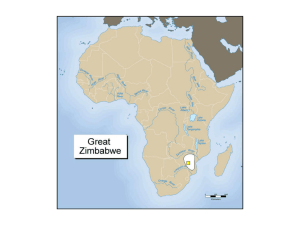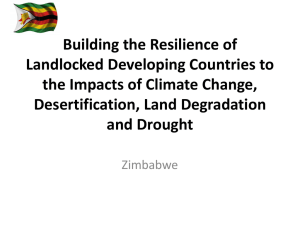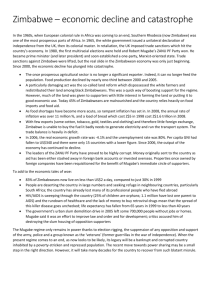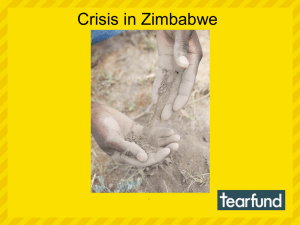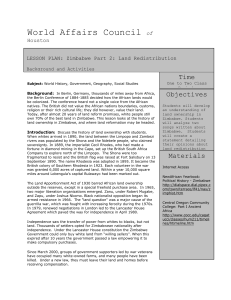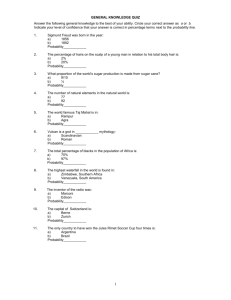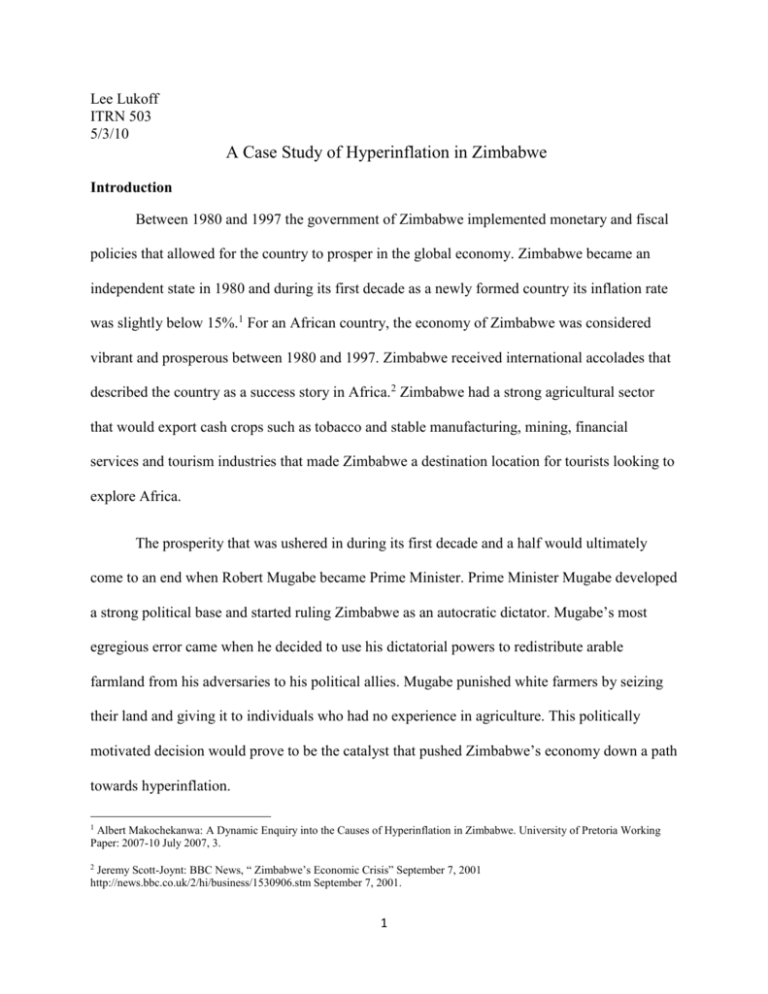
Lee Lukoff
ITRN 503
5/3/10
A Case Study of Hyperinflation in Zimbabwe
Introduction
Between 1980 and 1997 the government of Zimbabwe implemented monetary and fiscal
policies that allowed for the country to prosper in the global economy. Zimbabwe became an
independent state in 1980 and during its first decade as a newly formed country its inflation rate
was slightly below 15%.1 For an African country, the economy of Zimbabwe was considered
vibrant and prosperous between 1980 and 1997. Zimbabwe received international accolades that
described the country as a success story in Africa.2 Zimbabwe had a strong agricultural sector
that would export cash crops such as tobacco and stable manufacturing, mining, financial
services and tourism industries that made Zimbabwe a destination location for tourists looking to
explore Africa.
The prosperity that was ushered in during its first decade and a half would ultimately
come to an end when Robert Mugabe became Prime Minister. Prime Minister Mugabe developed
a strong political base and started ruling Zimbabwe as an autocratic dictator. Mugabe’s most
egregious error came when he decided to use his dictatorial powers to redistribute arable
farmland from his adversaries to his political allies. Mugabe punished white farmers by seizing
their land and giving it to individuals who had no experience in agriculture. This politically
motivated decision would prove to be the catalyst that pushed Zimbabwe’s economy down a path
towards hyperinflation.
1
Albert Makochekanwa: A Dynamic Enquiry into the Causes of Hyperinflation in Zimbabwe. University of Pretoria Working
Paper: 2007-10 July 2007, 3.
Jeremy Scott-Joynt: BBC News, “ Zimbabwe’s Economic Crisis” September 7, 2001
http://news.bbc.co.uk/2/hi/business/1530906.stm September 7, 2001.
2
1
Economic Costs of Hyperinflation
The land reform policies pushed by Mugabe immediately sparked a recession that was
accompanied by surging inflation. The agriculture base of Zimbabwe was for all intents and
purposes wiped out because of this ill-advised political decision. As agricultural exports dropped,
Zimbabweans were not able to acquire basic goods and services. This sparked a violent political
crisis in the country that severely hampered Zimbabwe’s tourism industry. In addition to hurting
domestic industries, Zimbabwe lost political and financial support from foreign governments and
aid organizations. During the time period between 1990 and 2007, Zimbabwe’s GDP went from
US$900 to US$200.3 The inflation rates increased from 47% in 1998 to 7,982% in 2007.4 With
such a drastic decline in productivity, unemployment in Zimbabwe skyrocketed. It was estimated
that upwards of 90% of the population was unemployed as of March 2009.5
Since Prime Minister Mugabe implemented his economic policies, Zimbabweans have
lost all confidence in their government. Many have resorted to violence towards their
government or have sought refuge in other countries because of the dire economic and political
situation that exists in Zimbabwe today. The political instability that has resulted from
Mugabe’s reign has been an added hindrance on Zimbabwe’s economy. According to the
Freedom House Political Rights and Civil Liberties Index, Zimbabwe is characterized as a
“repressive environment.6 A vast majority of the citizens of Zimbabwe do not have confidence in
the government of Zimbabwe or the Reserve Bank. Without any confidence in their political or
economic situation, it is highly unlikely that inflation will fall or that political and civil rights
3
Oxford Economics: Oxford Economic Country Briefings: March 30, 2009; ABI/INFORM Global, 4.
Terrence Kairiza: National Graduate Institute for Policy Studies: Unbundling Zimbabwe’s journey to hyperinflation and official
dollarization, 2
5 Oxford Economic Country Briefings, 3
6 Makochekanwa , 7.
4
2
will be restored. With no confidence in their system, it is unlikely that progress on either the
political or economic front can occur.
According to one economist, Zimbabweans must regain confidence in their public
institutions if they hope that inflation can be reduced in the future. Future expectations that the
economy can improve and that inflation levels will fall would likely lead to future economic
growth and future disinflation according to economist Robert Lucas. Lucas became famous for
enunciating a theory that became known as The Lucas Critique. The Lucas Critique states that if
wage setters could be convinced that inflation would be lower in the future that people would
ultimately decrease their expectations for higher inflation in the future.7 Lucas believed that this
would ultimately lead to lower inflation in the future without any long-term recession.8 The
Lucas critique is relevant in Zimbabwe because in this situation, the citizens of Zimbabwe do not
have confidence that their government can decrease inflation in the future because of how poorly
the Reserve Bank of Zimbabwe has performed at handling inflation. According to the Lucas
Critique, if citizens in Zimbabwe had confidence that their government could implement
deflationary policies, then deflation would be expected and a protracted recession would not
occur. For the citizens of Zimbabwe, restoring confidence in their public institutions is key to
restoring confidence in their economy.
Hyperinflation & Value of Money in Zimbabwe
Hyperinflation is a relatively rare economic phenomenon that has been documented only
a handful of times in the past century. The first documented case of hyperinflation occurred in
7
Oliver Blanchard: Macroeconomics Fifth Edition, Pearson Prentice Hall , 193
8
Ibid, 193
3
France during the French Revolution when inflation levels reached 143%.9 Perhaps the most
noteworthy example of hyperinflation occurred in Germany in the 1920s. During this time period
inflation reached an all time high of 30,000% in October of 1923.10 Since hyperinflation was
such a rare phenomenon, economists have never come to an official consensus about its
definition. The most widely cited definition of hyperinflation was first formulated in 1956 by
economist Philip Cagan. Cagan stated that hyperinflation begins in the first month that inflation
exceeds 50% and ends in the last month when inflation dips below 50%.11
Hyperinflation occurs when a country’s money supply is increased to unsustainable
levels. The end result of printing money without limit is that the value of the currency
depreciates until the currency becomes essentially worthless. Between January 2005 and May
2007, the Reserve Bank of Zimbabwe printed money at a rate that surpassed the rate that the
German government printed money during its famous hyperinflationary period during the
1920s.12 During this time period it was famously noted that it took a wheelbarrow of German
Marks just to buy a loaf of bread. In Zimbabwe, the dollar lost so much of its value that it was no
longer accepted as a medium of exchange in the open market.
The Reserve Bank of Zimbabwe unleashed its printing presses in 1997 to pay for a series
of expenditures that put Zimbabwe on the path to hyperinflation. Fearing a revolt from the
military, Prime Minister Robert Mugabe expanded benefits to soldiers who had recently served
in the military invasion launched into the Democratic Republic of Congo in 1998. Significant
government expenditures were also incurred when the Reserve Bank of Zimbabwe beefed up its
staff and when a legislative body of 66 Senators was created. Expansion of government services
Steven Hanke & Alex Kwok: On the Measurement of Zimbabwe’s Hyperinflation,353
Steven H. Hanke: Hyperinflation: Mugabe Versus Milosevic,1.
11 IMF Working Paper: Lessons from High Inflation Episodes for Stabilizing the Economy in Zimbabwe,3
12 Steven H. Hanke: Cato Institute Center for Global Liberty & Prosperity. “Zimbabwe: From Hyperinflation to Growth”, 3.
9
10
4
were financed by running the printing machines without end. The unfettered printing of money
in Zimbabwe was a recipe for disaster that ultimately created a situation where the Zimbabwean
dollar lost 99.9% of its value compared to the U.S. dollar.13
To fully understand hyperinflation one needs to understand how unbridled expansions of
nominal money negatively impacts the value of money. When the government prints money, the
resulting real revenue levels can be measured by the change in the money supply divided by the
price level. Seignorage is the concept used to measure how much real money can be derived
when a central bank prints new currency. Seignorage can be calculated in the following formula:
▲M/P. Seignorage is the product of nominal money growth and real money balances. The
higher the nominal growth of money the lower real money levels become. In other words, the
more money a government prints, the lower the value of the money. In addition to decreasing
real money levels, inflation rises as well. As we saw with Zimbabwe, when the Reserve Bank of
Zimbabwe increased nominal money growth the resulting policy effect was a 2.5 million percent
increase in inflation. 14
Despite astronomical levels of inflation estimated in some sources as exceeding over
3,000 percent a month, some believe that even these numbers underestimate the true rate of
inflation in Zimbabwe. Calculating the true value of inflation in Zimbabwe has been difficult
because of poor economic data that has been provided to the outside world by the Reserve Bank
of Zimbabwe. For example, the International Monetary Fund believes that Zimbabwe has
13
14
Ibid, 1.
Ibid, 1
5
miscalculated its Consumer Price Index (CPI) by including outdated price controlled goods in its
market basket.15
Blanchard defines CPI as “the cost of a given list of goods and services consumed by a
typical urban dweller.”16 Since price controls distort the true value of goods, an accurate CPI
can’t be calculated. Government-imposed price controls had a devastating effect on Zimbabwe’s
economy. Prime Minister Mugabe implemented a series of price controls to counter the negative
public sentiment that was brewing as inflation surged. The price controls implemented by Prime
Minister Mugabe had the effect of creating shortages of basic commodities which in turn led to
even higher prices.17 Because Prime Minister Mugabe’s price controls led to a CPI that was
calculated based on inaccurate prices. One can only wonder what the true value of Zimbabwe’s
CPI is when the effects of price controls are taken under consideration. Because its CPI has been
constantly undervalued, it is likely that Zimbabwe’s true rate of inflation may be even higher
than initially reported.
Impact of Hyperinflation on Foreign Trade & Foreign Aid
Prime Minister Mugabe’s attempt to seize land from white farmers had the effect of
crippling Zimbabwe’s agricultural exports. In 2000, agricultural output made up 18% of
Zimbabwe’s GDP; by 2002, that number had shrunk to 14% of GDP.18 Tobacco exports went
from USD 612 million in 1999 to USD 321 in 2003. Prior to his interventionist policies,
Zimbabwe had a vibrant mining and manufacturing industry. Zimbabwe is a country that is rich
15
IMF Working Paper: Lessons from High Inflation Episodes for Stabilizing the Economy in Zimbabwe,3.
Oliver Blanchard: Macroeconomics 5th Edition, Glossary.
17 Terrence Kairiza: Unbundling Zimbabwe’s journey to hyperinflation and official dollarization,5
18 Kairiza, 7
16
6
with a plethora of valuable natural resources. Zimbabwe boasts significant levels of gold,
diamonds, asbestos, chrome, coal, platinum, nickel, copper, petroleum and methane gas.19
Despite possessing valuable natural resources, the economic policies of Robert Mugabe
have severely crippled Zimbabwe’s ability to compete in the global marketplace. Mugabe’s
policies created a situation where the necessary capital cannot be expended to extract the
valuable resources that are spread throughout Zimbabwe. Typically, most countries that are poor
have scarce natural resources that inhibit their ability to complete in the global economy. In the
case of Zimbabwe, the opposite is true. Zimbabwe possesses a variety of valuable resources that
can not be processed and exported because of the toxic business climate that has pervaded the
country since Prime Minister Mugabe implemented his economic agenda.
Potential Policy Options to Counter Hyperinflation
In order to counter hyperinflation, Zimbabwe needs to adopt serious institutional reforms.
If they hope to reverse the current economic climate, the first thing that needs to be
accomplished is a contraction of the money supply and a decrease in government expenditures.
While such policies typically bring about a short-term recession, in the case of Zimbabwe the
economic conditions are so dire that these policies will have the opposite effect. Bolivia offers a
perfect example of how contractionary fiscal and monetary policies can create favorable
economic conditions in an inflation-plagued country. In two years’ time the deficit in Bolivia
went from 27% of GDP to 3% when contractionary monetary and fiscal policies were
implemented.20
19
United States Department of State: Diplomacy in Action. Official Country Profile: Republic of Zimbabwe.
http://www.state.gov/r/pa/ei/bgn/5479.htm#econ
20
IMF Working Paper: Lessons from High Inflation Episodes for Stabilizing the Economy in Zimbabwe ,7
7
After tightening the money supply and reducing government expenditures, the
government of Zimbabwe needs to adopt pro-market policies that will bring in economic growth.
Redistribution of wealth through land transfers needs to be entirely reversed so that Zimbabwe
can rebuild its agricultural export base. Price controls and other government policies that distort
the true value of goods and services within Zimbabwe need to be eliminated so that the market
for goods and services can return to an equilibrium level. Political rights and democratic reforms
need to be enacted so as to minimize the corruption in the Zimbabwean government that has
pervaded it since Robert Mugabe became Prime Minister. The central bank needs completely
new leadership that can properly manage the monetary supply and institutional staff. If central
banking is to remain a staple in Zimbabwe, a new generation of leaders must enter the central
bank that will not be beholden to the whims and passions of politicians who seek to maximize
political gain by exploiting the money supply to pay off political allies.
If the aforementioned policies are implemented successfully then it is likely that the
citizens of Zimbabwe will have a newfound sense of confidence in their domestic political and
economic institutions. When this occurs, the international community, foreign investors and
financial institutions will end their isolation of Zimbabwe and foreign investment and aid will
return, bringing an added surge of financial wealth that will help Zimbabweans regrow their
economy. When Zimbabwe can show that it has its political and economic house in order, the
country should have no problem regaining its position as one of Africa’s leading economic
powerhouses.
If the government of Zimbabwe is to ever regain the confidence of its people and the rest
of the world, then they must confront the failures of the country’s central banking system head
on. Three potential policy options exist that the Reserve Bank of Zimbabwe can implement to
8
usher in a period of disinflation to counter the hyperinflationary policies that have pervaded the
country for well over a decade. The first policy would be to adopt a dollarization strategy.
Dollarization is a policy where the government of Zimbabwe would cease to print money and a
foreign currency such as the U.S. dollar would become the primary medium of exchange. The
second policy option would be a currency board where the Zimbabwe dollar would become
backed by a foreign reserve currency that would oversee the Zimbabwean money supply.
Another potential option for Zimbabwe would be for the adoption of a free banking system. In
free banking private banks issue their own currency with little or no oversight from a central
bank. Each policy option offers a potential answer to the hyperinflationary crisis that has plagued
Zimbabwe since the Reserve Bank of Zimbabwe over-expanded the money supply.
Pursuing a policy of “dollarization” might be the best of the three policy options for
Zimbabwe. In many ways dollarization is already in action in Zimbabwe. To protect themselves
from inflation, Zimbabweans have invested their money in either US dollars or South African
Rands. Currently, Zimbabwe is in a state of unofficial dollarization because foreign currencies
operate alongside the Zimbabwean dollar. A policy of official dollarization would come about if
the Zimbabwean government decided to adopt a foreign currency as the sole legal medium of
exchange in the country. In fact, dollarization would not be a new thing to Zimbabwe. In the
1920s South African coins were used as an official medium of exchange in Zimbabwe.21 Such an
arrangement was mutually beneficial to both countries because of a profit sharing agreement
between the two nations.
Dollarization is appealing today because it would immediately bring stability to the
money markets of Zimbabwe. Stability in the money markets would allow for the free flow of
21
Steven H. Hanke: Cato Institute Center for Global Liberty & Prosperity. “Zimbabwe: From Hyperinflation to Growth”,5.
9
stable capital to resume in a country that hasn’t had a stable currency in over a decade. A stable
currency would boost consumer confidence levels and it would prompt an increase in
consumption. Increased consumer confidence would likely have a cascading effect that would
not only prop up the GDP of Zimbabwe but would also bolster foreign investment and foreign
aid from international monetary institutions. Since these institutions previously divested from
Zimbabwe, their newly found presence would undoubtedly bolster domestic economic growth by
increasing the levels of investment in the Zimbabwean economy.
Another option that Zimbabwe can adopt is the creation of a currency board. A currency
board is a system that relies on market forces to determine the size of a country’s money supply.
A currency board has 100% of its monetary supply backed by liquid foreign reserves. Adopting a
currency board would create a situation where the central bank could be unable to inflate the
money supply by printing new money. Only money that was backed a foreign asset could be
printed and loaned to commercial banks. This would have the effect of reducing inflationary
practices that central banks tend to engage in when they expand the money supply to give loans
to banks with money that is not backed by any asset. A currency board coupled with a fixed
exchange rate would likely restore confidence in the Zimbabwean dollar. Restoring consumer
confidence would undoubtedly put Zimbabwe on a path of disinflation that would create a
climate where commerce and economic growth can flourish once again.
The final policy option would be for Zimbabwe to adopt free banking. Free banking is a
system where private banking institutions issue their own forms of currency. In a free banking
system there is no central bank and little or no financial regulation. Each banking institution
issues currency based upon its ability to back the currency with its own financial reserves. While
the concept of banks issuing their own notes may seem foreign, it’s actually just an extension of
10
how current banks operate. Banks today compete with each other in a variety of ways, whether
it’s offering different interest rates on savings accounts or different types of financial wealth
management services. Free banking could be implemented in Zimbabwe if the Reserve Bank of
Zimbabwe deregulated its financial services industry and allowed for private financial
institutions to issue their own notes of currency. In a free banking system, financial institutions
would not be required to have reserve requirements or minimal capital requirements. In a true
free banking system no central bank would exist. Without a central bank printing money and
controlling the money supply , a free banking system would allow for each financial institution
to issue its own currency. In this situation, financial institutions would be able to issue their own
currencies. These currencies would float on an open market that would allow for separate
currencies to compete freely and fairly based upon the business practices that each financial
institution operated in a free market. Such a system would be the complete opposite of the prior
policies where currency values were held hostage to the policies of central bankers at the
Reserve Bank of Zimbabwe.
Conclusion
Zimbabwe faces tremendous challenges if it hopes to improve its economic standing in
the world. Serious reforms must be initiated to root out corruption and incompetence at the
Reserve Bank of Zimbabwe. If the Reserve Bank of Zimbabwe is to regain the faith and
confidence of the people of Zimbabwe, then it must implement serious contractionary policies to
limit the growth of the money supply and reduce the expenditures of the government. When
these policies are implemented, Zimbabwe needs to assess the future of its monetary system.
Central banking has proven disastrous for Zimbabwe in recent years. Whether this is the result of
11
poor management or the failures of central banking as a system are up for debate. However, it
must be noted that alternatives to central banking do exist. These alternatives can be easily
implemented if Zimbabwe decides that it has had enough of its current system. Whether it’s
implementing a policy of dollarization, free banking or implementing a currency board control,
Zimbabwe needs to get serious about financial reform if it hopes to restore the credibility of its
economy in the global marketplace. When Zimbabwe shows that it is serious about tackling
hyperinflation and rooting out corruption in its government, then it is entirely possible that the
economy in Zimbabwe could rebound and the vast natural resources within its land can be
utilized as a beacon for foreign investment, international trade and domestic prosperity.
Works Cited
1) Albert Makochekanwa: A Dynamic Enquiry into the Causes of Hyperinflation in Zimbabwe. University of
Pretoria Working Paper: 2007-10 July 2007, 3.
2) Jeremy Scott-Joynt: BBC News, “ Zimbabwe’s Economic Crisis” September 7, 2001
http://news.bbc.co.uk/2/hi/business/1530906.stm September 7, 2001.
3) Oxford Economics: Oxford Economic Country Briefings: March 30, 2009; ABI/INFORM Global, 4.
4) Terrence Kairiza: National Graduate Institute for Policy Studies: Unbundling Zimbabwe’s journey to
hyperinflation and official dollarization, 2
5) Oxford Economics: Oxford Economic Country Briefings: March 30, 2009; ABI/INFORM Global, 3
6) Albert Makochekanwa: A Dynamic Enquiry into the Causes of Hyperinflation in Zimbabwe. University of
Pretoria Working Paper: 2007-10 July 2007 , 7.
7) Oliver Blanchard: Macroeconomics Fifth Edition, Pearson Prentice Hall, 193
8) Ibid, 193
9) Steven Hanke & Alex Kwok: On the Measurement of Zimbabwe’s Hyperinflation, 353.
10) Steven H. Hanke: Hyperinflation: Mugabe Versus Milosevic,1
11) IMF Working Paper: Lessons from High Inflation Episodes for Stabilizing the Economy in Zimbabwe
12
12) Steven H. Hanke: Cato Institute Center for Global Liberty & Prosperity. “Zimbabwe: From Hyperinflation to
Growth”, 3
13) Ibid, 1
14) Ibid, 1
15) IMF Working Paper: Lessons from High Inflation Episodes for Stabilizing the Economy in Zimbabwe,3
16) Oliver Blanchard: Macroeconomics Fifth Edition, Pearson Prentice Hall, Glossary
17) Terrence Kairiza: Unbundling Zimbabwe’s journey to hyperinflation and official dollarization,5
18) Ibid, 7
19) United States Department of State: Diplomacy in Action. Official Country Profile: Republic of Zimbabwe.
http://www.state.gov/r/pa/ei/bgn/5479.htm#econ
20) IMF Working Paper: Lessons from High Inflation Episodes for Stabilizing the Economy in Zimbabwe, 7
21) Steven H. Hanke: Cato Institute Center for Global Liberty & Prosperity. “Zimbabwe: From Hyperinflation to
Growth”,5
13



